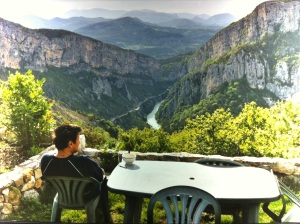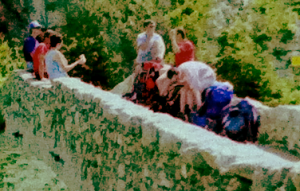
$12.00, really?
I was at Barnes and Noble’s the other day, when I saw this ION iPICS2GO pseudo-scanner in the bargains bin. Not really a scanner, though. It’s a sort of light box. There is no lens or imager inside. It’s just a stand where the iPhone actually taking and processing the pictures will be set.
Coupled with an iPhone, it can scan 3×5 and 4×6 prints, and, more interestingly, 24×36 negatives or slides.
The iPICS2GO was boxed, so I could not see it. But it was only $12. And even if it was a piece a junk, it was worth trying.
Unboxing
The whole thing is rather bulky (the size of a toaster), but it looks solid and well built. The negative holder and the 4×6 print holders are made of plastics of good quality and will not damage the originals, and the iPICS2GO will just needs four AA batteries to work. The print or the negative being scanned is lit by LEDs, which seem efficiently color corrected.
There is an iPICS2GO app on Apple’s app store, that you can download for free and use to control the camera of the iPhone. Although Apple’s built in Camera and Photos applications will give the same results if you “scan” a 4×6 print, you will need the ION application to enlarge and invert the 24×36 negatives. You could do it with Photoshop, but if you had a laptop and Photoshop, you would probably also own a real scanner and would not be interested in this product.
The core audience
As mentioned earlier, the iPICS23GO is not a scanner on its own. But paired with an iPhone 4, it forms a cheap and portable scanner, and its bundled application makes it easy to edit and share the scanned images, via e-mail or through Facebook. I can imagine a situation where you visit old friends or relatives, and they end up opening the proverbial shoe box where their favorite Kodak prints are stored. You scan a few pictures for immediate consumption on the iPhone, or share them around via email or on Facebook.
In this situation, the results are pretty good. IN order to benchmark the iPICS2GO, I scanned a 4×6 color print (the picture had been taken by a good 24×36 camera 10 years ago) with the ION box and with the real scanner of an all-in-one photo printer from Canon. Both images were transferred to a Mac, uploaded in Photoshop, and printed again. The Canon scan is a bit better (wider tonal range), but not that much. If the goal is just to casually look at old pictures on a smartphone, share them on Facebook or even print them again (4×6 prints, please, nothing larger), the ION iPICS2GO fits the bill.

Scanning negatives, on the other hand, is a much more difficult challenge.
The app does a good job at converting the negative into a positive image, whose quality is acceptable as long as you look at it on the iPhone (the original 24x36mm negative has a diagonal of 43mm; the screen of the iPhone has a diagonal of 3.5in, or 88mm – Th enlargement ratio is roughly 2:1). But don’t try to export it to a PC, or even worse, to print it. As soon as you enlarge it, the quality becomes unacceptable, as can be seen on close-up (below, on the right).



I have to admit that the ION iPICS2GO is much better gadget than I expected. If your goal is to take snapshots of your favorite prints every now and then in order to have them always with you on your iPhone, it’s perfect. You can also email your images or post them in Facebook directly from the ION app.
On the other hand, if the only source document you have is a negative, don’t expect miracles. In the best case, the resulting image will be somehow acceptable as long as you look at it on your iPhone. Beyond that, it’s hopeless. If you love the picture, bring the negative to a minilab.
But in any case, an old picture reborn on an iPhone is better than any image forgotten in a shoe box.

The original images were shot in France in “les Gorges du Verdon”, a small scale version of the Grand Canyon, in 2001. I don’t remember which camera I was using.

